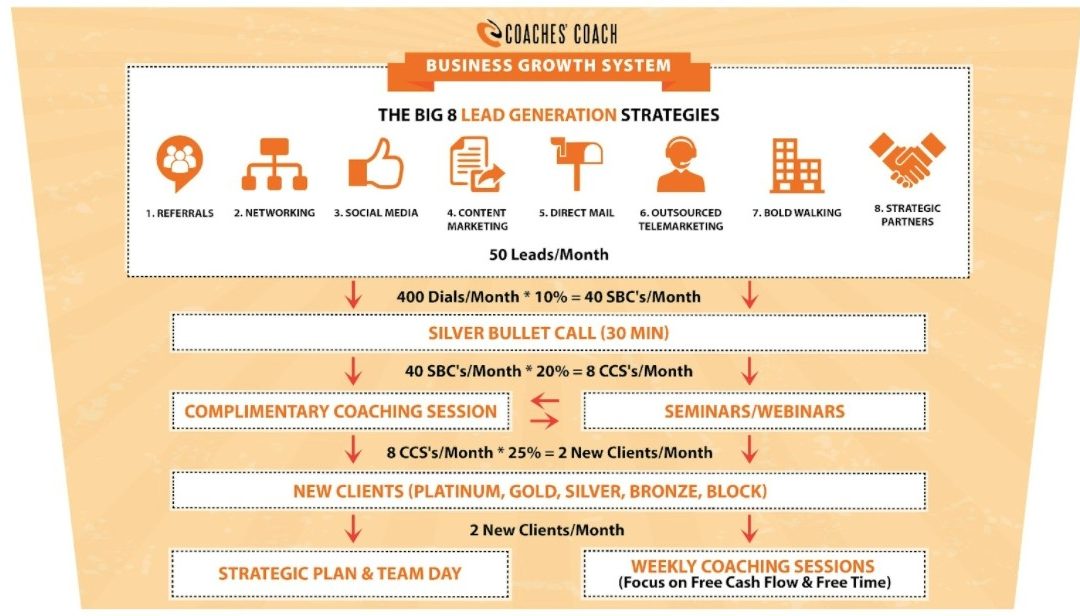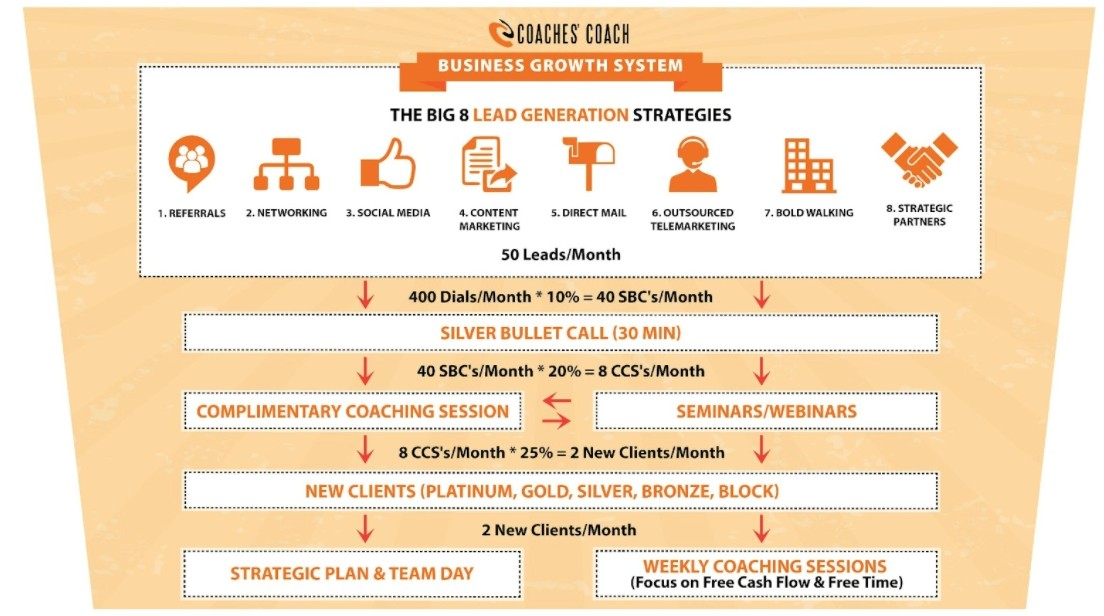
by Eric Dombach | Business Coach Training
Here’s some tough love. There are two types of business coaches: the struggle bunnies, who make some money sometimes, no money most of the time, and/or spend waaaaay too much time making way too little money; and the rock stars, who are absolutely crushing it, making more and more money, and spending less and less time doing it. What separates them? The ability to generate consistent, high-quality business coaching leads on demand.
In fact, if you can’t predictably generate and convert leads and coach those clients into raving fans, then you don’t have a business…and never will.
At the end of the day, the only things that matter are:
- Setting up Complimentary Coaching Sessions with prospects.
- Converting those prospects into clients.
The end.
So how many Complimentary Coaching Sessions did you do in the past seven days? What did you do in the last seven days to schedule Complimentary Coaching Sessions?
If you don’t know the answer to that question, or if the answer is “not as much as I should have done,” then sit tight. Below, I’ll reveal the exact formula it takes to generate consistent lead flow, month over month.
A Formula That Will Yield Two New Clients/Month
One thing I hear a lot from my business coach clients is that they don’t have any consistent metrics or targets to help them guide their lead generation efforts. Sometimes their efforts yield new clients almost accidentally; more often than not, there’s a lot of hand-wringing and throwing spaghetti against the wall, and very little to show for it.
Here at the Coaches’ Coach, we’ve worked with thousands of business coaches over nearly two decades, so we’ve been able to track the activity the average coach needs to commit to each month in order to yield two clients consistently.
Can you imagine the difference in your business if you knew that every month, you’d have two new clients signing up for coaching?
You wouldn’t have to panic over normal attrition. You could scale up the quality of your client base–that is to say, you could fire your problem clients as you replace them with better ones, and steadily and surely increase your rates and the financial stability of the businesses you work with. You could make more money while working fewer hours.
Can you imagine the difference in your business if you knew that every month, you'd have two new clients signing up for coaching? You wouldn't have to panic over normal attrition. You could scale up the quality of your client base--that is to say, you could fire your problem clients as you replace them with better ones, and steadily and surely increase your rates and the financial stability of the businesses you work with. You could make more money while working fewer hours.
Here’s what it takes:

Generate 50 Business Coaching Leads Per Month
Your first step is to generate at least 50 new leads per month. You do this using a combination of what we call the “Big 8” lead generation strategies:
- Referrals — tapping your existing network for people in need of your services;
- Networking — attending business meet-ups, conferences, or other opportunities to meet new prospects;
- Social media — creating an engaging social presence that includes targeted advertising;
- Content marketing — crafting compelling digital content that educates and inspires prospects to take the next step;
- Direct mail — yes, believe it or not, old school mail is still effective;
- Outsourced telemarketing — hire a firm to do the cold calling for you;
- Bold walking — physically walk into businesses and meet their leadership teams;
- Strategic partners — work with businesses that serve a similar market to your ideal clients to make your services available to their customer list.
Make 400 Dials Per Month
Next, you should make 400 dials to prospects per month. These are known as “warm calls.” These are calls to the new, warm leads you’ve generated (highest priority) as well as previous prospects and contacts. Don’t have enough leads to create that many dials? Do it the old-fashioned way–cold call. Cold calling isn’t anyone’s favorite thing, but it helps you get in the habit of making regular phone time a priority. As you continue to execute your lead-generation efforts, soon you’ll have to do less and less of it.
Hold 40 Silver Bullet Calls Per Month
Of the 400 dials you make per month, expect about 10% to convert to a 30-minute “Silver Bullet” call for about 40 of these per month.
These are short conversations that allow you to understand the needs of your prospective clients and begin to demonstrate your value to them. Don’t overstay your welcome here. Keep it short and sweet. Your goal is to set up a longer Complimentary Coaching Session with your prospect, with the agreement that at the end of it, you’ll mutually decide whether or not to move forward with coaching.
Conduct 8 Complimentary Coaching Sessions Per Month
Expect about a 20% conversion rate from your Silver Bullet calls to a full, 60-minute Complimentary Coaching Session. So if you have 40 Silver Bullet calls, this should yield 8 Complimentary Coaching Sessions.
This is where you and your client will decide whether or not to work together. As I mentioned above, these are the single-most-important meetings you can schedule if you want to grow your business. Master these and you’ll be well on your way.
Some prospects need a little more warming up; hold regular seminars and webinars you can invite your prospects to. You can convert Silver Bullet calls to webinars, and on to Complimentary Coaching Sessions; or you can convert prospects that are still on the fence after your Complimentary Coaching Session to your webinar and get another shot at them.
Close 2 New Clients Per Month
Most coaches can expect to convert at least 25% of their Complimentary Coaching Sessions into clients. (Actually, I’ve had months with 80%+ conversion rates, but I’m being conservative here on purpose.) If you have 8 Complimentary Coaching Sessions per month, this will yield two new clients.
So you see? Now you know what you need to do each month!
Generate 50 leads –> Make 400 dials –> Hold 40 Silver Bullet Calls –> Conduct 8 Complimentary Coaching Sessions –> Close 2 New Clients
Take this as your benchmark. As your conversion rates improve, or you want to scale faster, you can adjust these targets to fit your goals.
The important thing is to be consistent. Invest in your marketing and lead generation. Make it your top priority. It’s the only way to avoid being a struggle bunny and take your place among the ranks of the business coaching rock stars!
And for more incredible strategies and analysis like this, download our FREE ebook, Secrets of a Business Coaching Rock Star. You’ll be glad you did.

by Eric Dombach | How to Become a Business Coach
You know, there’s one question I often hear from people who are considering a work-from-home career as a business coach: Can I really make it as a business coach?
It’s an important question.
After all, starting an at-home business isn’t easy. There are hundreds of pie-in-the-sky promises out there—and that can make it difficult to sort the real opportunities from the snake-oil salesmen.
So the first thing you need to know about business coaching is this:
It’s NOT for everyone.
I know, I know, probably the last thing you expected to hear. But you need to hear it.
Business coaching is NOT about instant riches. It’s NOT about “making money while you sleep.” It’s NOT about downlines or fast, easy cash, or any number of on-the-spot wealth schemes that are too good to be true.
Instead, it’s about working hard…working smart…and making a legitimate full-time income working part-time hours from home.
Business coaching is NOT about instant riches. It's NOT about "making money while you sleep." It's NOT about downlines or fast, easy cash, or any number of on-the-spot wealth schemes that are too good to be true. Instead, it's about working hard...working smart...and making a legitimate full-time income working part-time hours from home.
I want to be perfectly clear on this point: if you’re looking for some sort of no-work formula that will put money in your pocket “magically” and overnight, there’s an EXIT button at the top of your browser. Do us both a favor and click it.
But if you’re willing to put in some time and energy learning an incredible new business that helps people succeed, then stick around. Because that’s what business coaching is all about.
So…what can you expect to earn? Let’s take a look at some realistic figures…
What Could You Do with an Extra $24,000 a Year?
Let’s say you have just ONE coaching client paying you $2,000 a month. That would put an extra $24 grand in your pocket each year. Sure, it’s not enough to retire on…but what could you do with an extra $24,000?
Pay off debt? Send a kid to college for a year? Finish saving that down payment for the home you’ve been eyeing?
Of course, most business coaches have more than just one client…they have 5, 10, 15, or more. Now you’re talking income in the neighborhood of $120,000… $240,000… $360,000.
Now, I’m sure the next question on your lips is this: will I really be able to land new clients? Will I really be able to make this business work? Will I really be able to generate the kind of leads I need to pull in this kind of revenue on a consistent basis?
Well, if past performance of my coaches is any indication…the answer is an unqualified YES.
Look, there are never any guarantees in business. So while I can’t make any promises, what I can tell you is that over the course of my career as a business coach, I personally coached more than 165 business owners and collected more than $2.8 Million in coaching fees. I kept coaching clients for an average of 19 months — nearly double the industry average — and had a stack of testimonials from raving fans who directly attributed their business success to my coaching.
Then, I turned around and completely systematized everything I did when I launched the Coaches’ Coach over a decade ago. Since then, hundreds of business coaches have been able to duplicate my efforts. Many of them are pulling in six figures a year.
It’s not rocket science. It’s systematic. And if you’ve got the right personality and motivation, YOU can do it too.
Want to get started? Check out my FREE ebook, How to Become a Business Coach for a step-by-step guide to launching and growing your own business coaching practice.

by Eric Dombach | Business Coach Training
Recently, during one of my Rockstar Coaching Program group coaching sessions, I said something that really seemed to resonate with the audience. It was simple, actually…
You’re not too late.
You’re not too late because the world-changing ideas that will revolutionize everything in just a short decade from now probably haven’t even been thought of yet.
You’re not too late because the next Facebook, Uber, or Airbnb is still between someone’s ears.
You’re not too late because a comprehensive study recently found that your most productive years will be between the age of 60 and 70…the second-most productive years will be between 70 and 80…and the third-most productive years will be between 50 and 60.
(BTW I’m thinking the same thing you’re thinking right now…I gotta start drinking more green juice!)
You’re not too late because the average age of Nobel Peace Prize winners is 62…the average age of prominent CEOs is 63…the average age of pastors running the largest churches is 71…Heck, the average Pope is 76.
You’re not too late because the best years of your life are between 60 and 80
Yowza!
You heard it here first.
You’re not too late to make a huge difference, both in your family’s life and in the lives of your clients.
And no, I’m not just talking about their business lives. I’m talking about all of it.
Marriages break up from lack of money over lack of love a hundred times more regularly.
Business failures lead to destruction, addiction, depression, anxiety, suicides, and unfortunately, far more.
As good business coaches, we save marriages, we save families, we save kids from self-destruction… we save lives!
As good business coaches, we save marriages, we save families, we save kids from self-destruction… we save lives!
A life of true purpose.
And it’s not too late to make it happen.
Now, pick up the phone and go help someone.
Want to learn how to do it more effectively? It’s never too late to start. Check out our FREE ebook, Secrets of a Business Coaching Rock Star.

by Eric Dombach | Business Coaching Tools
Running a successful business coaching practice requires more than just an effective marketing strategy and excellent coaching skills (though those are the basics, of course). There are particular tools and resources that help everything run more smoothly–from cloud-based software to service providers that make all the difference.
So today, I thought I’d peel back the curtain on what we use here at the Coaches’ Coach to make our business hum along–as well as the resources we recommend to our clients. Note: we’re not affiliates for any of these (with the exception of ConnectAndSell), we’re just sharing the love because they’ve helped us and can certainly help you!
Running a successful business coaching practice requires more than just an effective marketing strategy and excellent coaching skills (though those are the basics, of course). There are particular tools and resources that help everything run more smoothly--from cloud-based software to service providers that make all the difference.
Tech Tools
Website: WordPress + Divi Builder
Our website is built on WordPress, using the Divi Builder by Elegant Themes. This is front-end, drag-and-drop builder made it easy for our designer and developer to put together the fresh, mobile-friendly look you see here; plus, it’s intuitive enough for my virtual assistant to make edits in a pinch. If your website is a little lackluster, hire a freelancer to use WordPress and Divi to give your site a makeover. These days, a good-looking, well-functioning website isn’t optional; it’s foundational for any business to grow.
CRM: Keap/Infusionsoft
We’ve used Keap (formerly known as Infusionsoft) as our core CRM and sales and marketing automation tool for over a decade. It’s a robust inbound marketing platform that allows us to create and send email campaigns, follow up automatically with prospects, process payments (including recurring payments), and keep in touch with our clients. It’s robust, and so requires some training to get everything out of it, but their onboarding process is thorough and they update regularly to stay on-trend with the latest marketing tactics.
Marketing: Click Funnels
We use Click Funnels to quickly and easily create landing pages for our ebooks and resources. It integrates with Keap, so that our data doesn’t get lost, and allows us to build, launch, and test multi-step marketing and sales funnels. They have built-in A/B testing functionality that allows you to make sure your campaigns are as effective as possible.
Outsourced Talent
Phone-Based Lead Generation: ConnectAndSell
Over the years, we’ve used dozens of vendors that provide outsourced telemarketing and appointment setting. One of our favorites is ConnectAndSell. They’ll call prospects for you and set appointments on your behalf, so that you can focus less on cold calling and more on converting prospects and appointments to paying clients.
Everything Else: Upwork
Upwork is the world’s largest freelance marketplace. We’ve used it regularly over the years to find copywriters, web developers, designers, virtual assistants, and more. Whether you’re in need of temporary, project-based work, or ongoing help, you should be able to find someone on Upwork. The contractors on Upwork are rated and vetted, and your money is protected: if your contractor doesn’t deliver as agreed, you can recoup your investment. They also handle things like 1099s and reports.
Sales Tools
Automated Scheduling: Calendly
Want to stop going back and forth trying to find appointment times? Want to be able to turn your calendar over to your outsourced telemarketer or virtual assistant to make appointments on your behalf? Calendly integrates with your Google or Outlook calendars and allows people to book their own meetings at a time that works for you both. The free version is perfectly adequate for most business coaches, although some of their premium packages offer nice perks.
Prospect Research: People Looker
If you’re prospecting for new potential clients or strategic partners, you know the experience of being unable to find the contact information for the decision-maker. People Looker offers an affordable monthly membership that will search public records and very often finds up-to-date contact information for folks you might have trouble contacting otherwise! (Quick note: with great power comes great responsibility. Be sure to read the terms and conditions for what is an ethical, vs. unethical, use of this data!)
These are just a handful of the tools and resources we use at the Coaches’ Coach to keep our business firing on all cylinders. We peel back the curtain even more on the tools we recommend inside our membership portal. Get a FREE 30-day trial to see even more!

by Eric Dombach | Business Coaching Systems
Welcome to this special post on the importance of gross profit margin, co-written by Karl Bryan and Eric Dombach. Use this as you do end-of-year budgeting and forecasting with your coaching clients!
High Gross Profit Margin: The Metric that All Successful Companies Share
All successful companies have ONE THING in common: a high gross profit margin.
Unfortunately, most business coaches don’t even know what that means–let alone how to help their high-end clients in this area.
Simply put, gross margin is sales minus the cost of goods sold. Calculate sales after returns and discounts, and cost of goods sold before overhead like marketing and facilities. The higher the margin, the more fail-proof the business is. Many of the largest companies in the world have extremely high gross profit margins. For example, Apple’s is about 40%, Google hovers around 60%, and Meta (the company formerly known as Facebook) is around 80%.
Gross profit margin is sales minus the cost of goods sold. Calculate sales after returns and discounts, and cost of goods sold before overhead like marketing and facilities. The higher the margin, the more fail-proof the business is.
Want to help your clients improve theirs? Consider these questions:
- Does your client have a $10,000+ product with a minimum of 50% margin?
- If they have that, do they have a $25,000 product with a minimum 50% margin?
- If your coaching client’s business could talk… what would it say to your business coaching client?
- What, specifically, has the owner been ignoring–and what, specifically, needs to be completed?
- Does your client have financial statements (please don’t mistake tax returns for financial statements… it’s embarrassing)?
- If so, are they reviewed (specifically, itemized expenses) quarterly?
- If not, how will they make that (financial statements) happen?
If you don’t know the answers to these questions–and, particularly, what the answers should be, and how to help your clients develop the products and systems they need to succeed, hang tight. My buddy Eric will share some Silver Bullets that can help.
-Karl Bryan
Meet the Silver Bullets that Matter to Gross Profit Margin
Karl is right that the most successful companies in the world have a high gross profit margin–and that one of the best ways to help your clients improve is by teaching them how to achieve it.
Enter the 21 Silver Bullets.
This is a framework I invented years ago, when I knew I needed a more effective way to teach clients basic business-building skills–and to communicate the value of coaching to them.
What Silver Bullets would I use to help my clients answer the questions Karl raised above? Try these on for size:
- Create a Compelling Unique Selling Proposition and Guarantee. If you want to put your clients in a position to be able to create and sell premium products with at least a 50% margin, as Karl suggests, break out the USP and Guarantee Silver Bullet. This will help clients position themselves more effectively in the market by competing on factors other than price. In the process, they’ll learn to create outstanding perceived value that opens the door for high-profit, premium pricing models.
- Update the Current Business Plan. If your client’s business isn’t talking to them, it’s almost certainly because they don’t have a Current Business Plan, complete with cash-flow projections and working capital requirements. Plus, it will provide them all the financial info they need at a glance. If this is a problem, send this Silver Bullet their way.
- Close the Cash Gaps. If your client’s sweating payroll or other expenses every month, even if their gross profit margin is okay otherwise, they have a cash-flow problem. The fix here is the Cash Gap Plan, which takes them through a series of seemingly small tweaks to things like vendor terms and payment collection processes that can pack a big punch. Often, these small things are ignored and neglected, to the great detriment of the business.
- Be Sure They’re Breaking Even. If your client’s in a particularly bad way, implement the Break-Even Plan Silver Bullet to stop the bleeding. This will help them understand exactly what they need each month to cover their costs, so that they can right the ship and put themselves in a position to begin growing again.
This is vitally important work. And now, as the year comes to a close, you have a perfect opportunity to help them get on track to a more efficient, more productive, more profitable business.
-Eric Dombach
Want to see all 21 Silver Bullets in action? Get a FREE 30-day trial of our comprehensive business coaching system and learn what they are–and how to introduce them to your clients and prospects.
Page 6 of 22« First«...45678...20...»Last »






